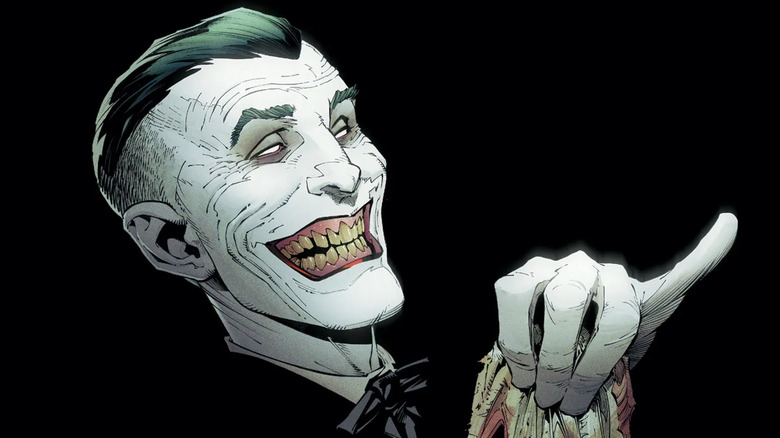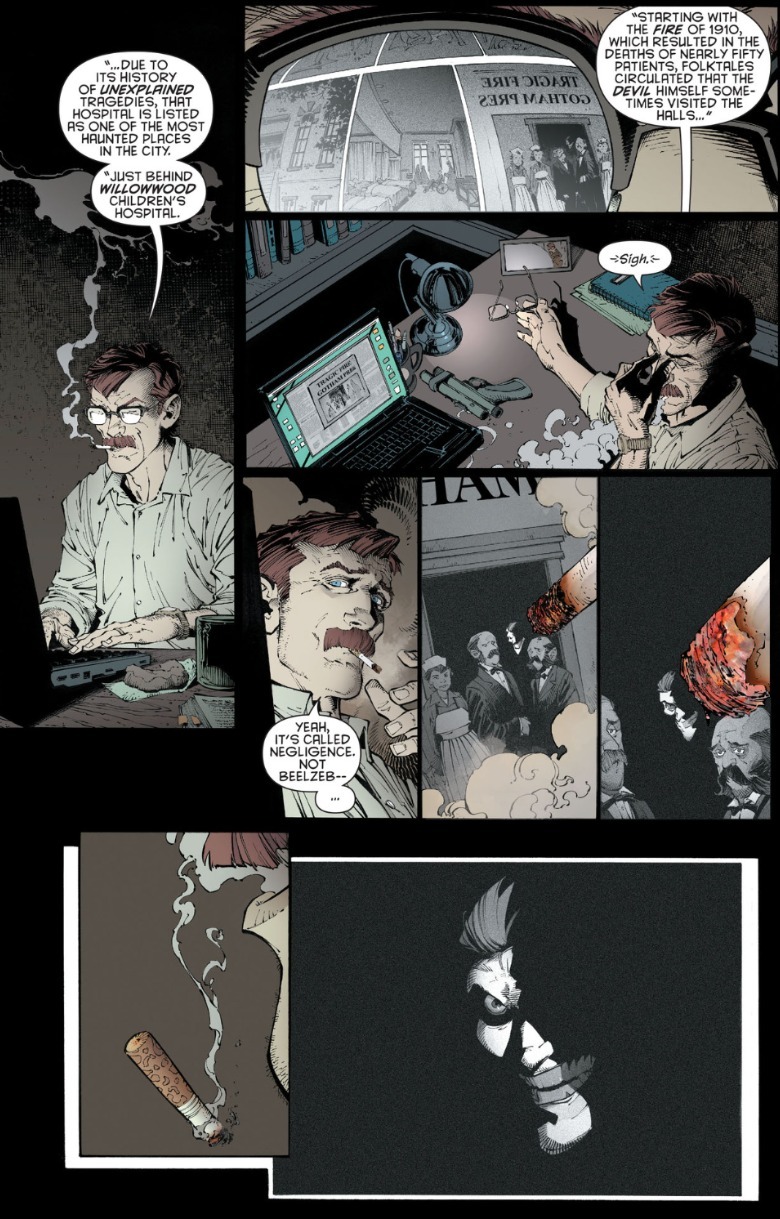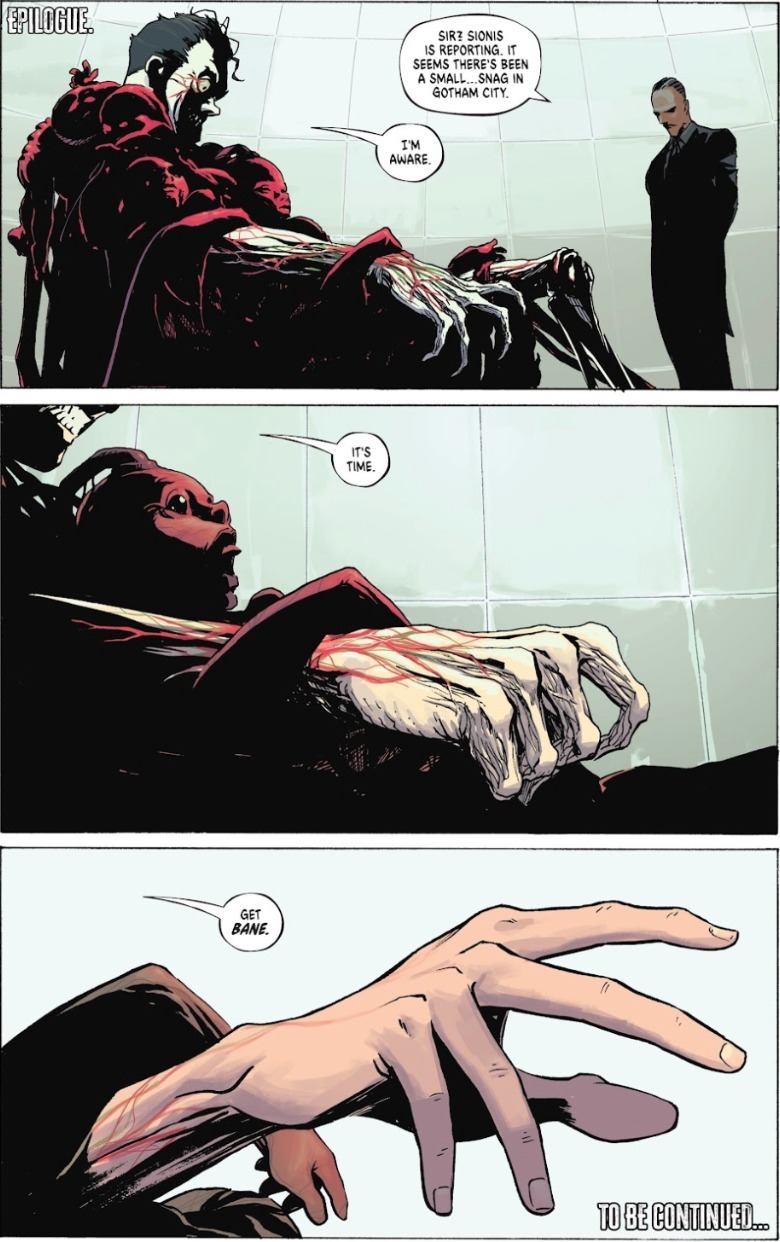This Batman Comic Turned The Joker Into Stephen King's Pennywise
We may receive a commission on purchases made from links.
The two most famous evil clowns in pop culture are the Joker from "Batman" and Pennywise from Stephen King's "IT." Yet while equal in their malevolence, Pennywise is in another league of evil. Pennywise is not really a "dancing clown," but a cosmic horror that has long slept under Derry, Maine. Every 27 years, it awakens to feast on the town's children and their fear. The Joker has no set origin, but the usual story is he was a normal man who fell into a vat of chemicals, then walked out with bleached skin, green hair, and a permanent smile.
The writer who has most bridged the two characters is Scott Snyder, who wrote "Batman" from 2011 to 2016. Snyder has cited King as a formative writing influence for him, and he even got King to write a story for his horror comic "American Vampire." Snyder's background in horror meant one of the strengths of his "Batman" run is how scary it can be. In his arc "Endgame" ("Batman" #35-40, art by Greg Capullo), he sought to make the Joker scarier than ever and offered a new answer to his "multiple choice" past.
The Joker often seems to be in love with Batman, or at least fixated on him as the only one who "completes" him. The terrifying question "Endgame" presents is: what if he fell out of that love? In Snyder and Capullo's first Joker arc, "Death of the Family," Batman rejected the Joker's offer to run off together, so the spurned clown is out to "close up shop." "Endgame" is no generic title but a play on words; the Joker is ending his endless game with Batman... or rather, Bruce. No longer worried about spoiling his fun by peeking too closely, the Joker has learned Batman's true identity.
In "Batman" #37, as Jim Gordon sifts through photos of tragedies from Gotham City's history, he makes a startling discovery. Over the centuries, whenever there's been suffering or a disaster in Gotham, there's a pale man grinning and laughing in the background.
The Joker, it appears, is an immortal or a demon who has been haunting Gotham since its founding. His persona as Batman's arch-nemesis, the Clown Prince of Crime? Merely the latest iteration of this evil. But couldn't these images be doctored? Perhaps, but then Gordon shoots the Joker dead... and the clown gets right back up. What kind of man could do that but no man at all?
"Endgame" ultimately backed away from this idea at the end, but Snyder is back writing new series "Absolute Batman." Once more, he's suggesting Joker is much older than he looks — and this time, I don't think he'll balk.
Batman: Endgame suggested the Joker has been haunting Gotham for centuries
Batman plays on criminals' fears that he's something more than human, like a living shadow or a specter sent to make them pay for their sins. That fear is turned back on Batman in "Endgame," as he's taunted with the idea his worst enemy might be worse than he ever imagined.
The comic puts us in Batman's shoes; we believe the Joker must be lying ... but what if he isn't? It does make a twisted amount of sense if the Joker is a supernatural force. That explains why he relishes evil to a degree no other villains do, why he's impossible to kill, why he seems to have no history or identity before he became the Joker, etc.
One of Snyder's favorite Batman comics is Peter Milligan and Kieron Dwyer's "Dark Knight, Dark City." That comic looked back into Gotham's history; in the 1760s, a group of men attempted the occult "Ceremony of the Bat" to attain great power, but failed, trapping the bat demon Barbatos beneath Gotham. The city is literally cursed, for Barbatos' evil resides in Gotham's soil, water, brick, and mortar.
Snyder's opening "Batman" arc, "The Court of Owls," introduced the titular secret society that has controlled Gotham City since its founding. "Court" is a story all about the history of Gotham City — and Batman realizing he's just a small part of it. In "Endgame," when Batman needs definite proof on whether the Joker has been in Gotham for centuries, he goes to the Court of Owls.
"Endgame" builds on "The Court of Owls" the way that story builds on "Dark Knight, Dark City." But in the end, the idea of "the Pale Man" turns out to be just be the Joker's latest prank on Batman.
The MacGuffin of "Batman: Endgame" is a fictional chemical called Dionesium which gives human bodies advanced healing abilities. This chemical is the base element of the Lazarus Pits, the fountains of youth that have kept Ra's al Ghul alive for centuries. The Joker found a pool of untainted Dionesium beneath Gotham, which he used to make a new strain of Joker Venom and give himself rapid healing abilities. He's become immortal and his new abilities inspired him to make Batman think he's always been like that.
In a post "Endgame" interview with IGN, Snyder said, "I wanted it to be pretty definitive that this has been a joke [the Joker has] been playing, a torturous thing on Batman [...] To make it as definitive as possible without shutting the door entirely."
"Batman" writers since haven't followed up on that still open door, but Snyder now has the chance to himself.
Absolute Batman might finally give us an immortal Joker
The reason "the Pale Man" myth in "Endgame" was never totally convincing, and in the end wasn't real, is because it would be too fundamental a change to the Joker's character. Superhero comics, like "Batman," have to reset to the familiar. The Joker has been ingrained in pop culture as a human villain, with no more powers than Batman himself. Turning him into a Pennywise-esque demon would completely upend that... but "Absolute Batman" is all about upending the typical Batman story.
Snyder and artist Nick Dragotta have been innovating from their first issue. "Absolute Batman" #1 somehow put a new, relevant spin on Batman's omnipresent "my parents are dead" origin story. Here, Bruce's father Thomas Wayne was a teacher killed in a mass shooting, while his mother Martha Wayne is still alive when he becomes Batman. Bruce remains a self-taught polymath, but he's not a playboy billionaire; he's a working class engineer. He's still a son of Gotham, but not its prince, and so a better hero for this moment.
The one who is a billionaire in the "Absolute" universe? The Joker. He's only appeared briefly so far, but he's the master of Bane (villain of current arc "Abomination") and his company J.K. Holdings is funding violent crime, "Ark" black sites (Gotham holds Ark M), human experimentation, and more. How has the Joker acquired this fortune? Maybe because he's been around a while.
The Joker's origin is going to be told in "Absolute Batman" #15 (drawn by guest artist Jock), which based on current scheduling should be out this December. Snyder teased the issue at DragonCon 2025, saying this: "It starts with someone you think is Joker's great-great-grandfather in the early 1800s who is a clown on the streets of Gotham. It keeps revisiting this idea of who this clown was and what did he do, getting darker and darker."
From that wording, I think the twist of the issue is that it's not "the Joker's great-great-grandfather" in the 1800s, but the Joker himself. "Absolute Batman" has already laid some groundwork for this. "Absolute Batman" #6's final page shows the Joker; his skin is haggard white and his body so lean he's practically a skeleton. He's hooked up to what appears to be a mass of blood red infants, and slowly regains his healthy appearance. Is the Joker literally keeping himself alive unnaturally with fetal blood?
Scott Snyder's first run on "Batman" is plenty impressive, but he still had to play by the rules of DC's continuity. Now, he's making up the rules and refining his best ideas along the way.
"Absolute Batman" issues #1-12 are currently available for purchase; issue #13 is scheduled for release on October 8, 2025.




